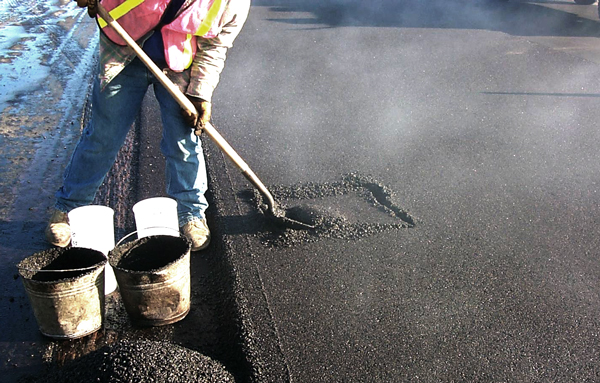Raise the Feel And Look of Your Residential Property with Professional Commercial Parking Great Deal Paving
Raise the Feel And Look of Your Residential Property with Professional Commercial Parking Great Deal Paving
Blog Article
Unlocking the Secrets of Hot Mix Asphalt Innovation
Checking out the midsts of warm mix asphalt modern technology uncovers a world where precise formulations and precise processes merge to form our roadways and framework. The blend of binders, fillers, and accumulations isn't merely a building task however a strategic orchestration of resilience and effectiveness. As we peer into the elaborate dance of components, a tapestry of resilience and sustainability unravels. Yet what exists underneath this surface area of asphaltic mastery, and what secrets wait to be unveiled in the world of leading innovations?
Significance of Warm Mix Asphalt
Hot Mix Asphalt plays an important role in contemporary infrastructure growth due to its longevity and cost-effectiveness. As the most commonly utilized leading material for roadways, highways, and parking area, Warm Mix Asphalt provides an array of benefits that contribute to its relevance in building tasks. One essential benefit is its ability to stand up to hefty web traffic lots and harsh climate condition, offering a dependable and resilient surface area for transportation networks. Furthermore, Warm Mix Asphalt is cost-effective in both preliminary building and construction and long-term maintenance, making it a favored selection for many infrastructure jobs.
The toughness of Hot Mix Asphalt stems from its composition, which consists of accumulations, binder, and filler materials that are carefully picked and mixed to meet details performance requirements. On the whole, the value of Hot Mix Asphalt in framework advancement can not be understated, as it proceeds to be a foundation of modern building and construction techniques.
Parts of Asphalt Mixes
The composition of asphalt mixes is composed of carefully chosen accumulations, binder, and filler products that are essential for attaining specific performance demands. Accumulations are the primary component of asphalt blends, giving toughness and stability. The binder, commonly asphalt or asphalt cement, holds the aggregates with each other and gives adaptability and resilience to the mix.
The combination and percentage of these parts play a substantial role in identifying the high quality and efficiency of the asphalt mix. Designers meticulously design the mix to meet particular demands, thinking about variables like website traffic quantity, environment problems, and sidewalk life-span. Correct selection and balancing of aggregates, binder, and fillers are essential for creating durable, long-lasting asphalt pavements.
Mixing and Manufacturing Strategies

When the accumulations are picked, the binder, frequently asphalt cement, is included in bind the products with each other. The binder's top quality and amount significantly impact the mix's resistance, stamina, and versatility to environmental elements. Furthermore, fillers like hydrated lime or Portland cement might be included to boost details features of the asphalt mix, such as its workability or dampness resistance.
Throughout manufacturing, the aggregates and binder are heated, generally between 250-325 ° F(121-163 ° C ), to facilitate blending and make certain correct finish of the accumulations. The mixing process has to be thorough to attain an uniform mix that promotes the desired efficiency attributes of the asphalt. Different methods, such as batch blending or drum mixing, are employed to attain constant and premium asphalt blends for building projects.
Variables Impacting Asphalt Performance
Variables affecting asphalt performance incorporate a variety of variables that influence the longevity, durability, and overall high quality of asphalt pavements. One vital element is the top quality of materials used in the asphalt mix. The kind and source of accumulations, the binder quality, and the ingredients all play a significant duty in identifying the efficiency of the asphalt pavement. The rank of aggregates is vital as it affects the mix's resistance, stability, and workability to fracturing and rutting.

Design factors to consider, such as sidewalk density and drainage, are crucial in ensuring the long-lasting efficiency of the asphalt sidewalk. By meticulously considering these contractors, engineers and factors can optimize asphalt performance and boost the solution life of sidewalks.
Lasting Practices in Asphalt Modern Technology

WMA allows for the manufacturing and placement of asphalt blends at lower temperature levels compared to standard hot-mix asphalt, resulting in reduced power consumption and greenhouse gas discharges. The usage of porous asphalt blends can help alleviate stormwater runoff problems by permitting water to infiltrate via the pavement and into the ground, advertising natural water filtering and reenergize processes.
Final Thought
In verdict, warm mix asphalt technology plays a vital duty in modern-day infrastructure development because of its resilience and cost-effectiveness. By meticulously balancing components, using correct blending strategies, and thinking about various aspects, designers can develop top notch asphalt mixes that withstand rush hour loads and severe climate conditions. their explanation Embracing lasting techniques, such as making use of warm-mix technologies and recycled materials, better boosts the environmental friendliness of asphalt innovation.
Blending and manufacturing strategies in hot mix asphalt innovation involve the accurate mix and handling of accumulations, binder, and fillers to create a high-performance and sturdy asphalt mix.Variables influencing asphalt efficiency include a variety of variables that impact the durability, longevity, and total quality of asphalt sidewalks. Lasting practices in asphalt innovation encompass numerous efforts aimed at minimizing the environmental influence of asphalt manufacturing and paving procedures. By including recovered asphalt pavement (RAP) and recycled asphalt roof shingles (RAS) into new asphalt mixes, the market can dramatically minimize the intake of raw products and power, while also lowering landfill waste.
WMA enables for the manufacturing and positioning of asphalt mixes at lower temperature levels compared to standard hot-mix asphalt, resulting in lowered power intake and greenhouse gas discharges.
Report this page